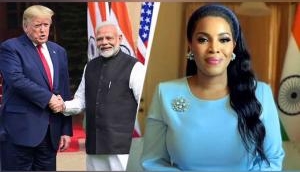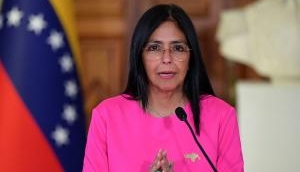NSA Ajit Doval heads to China: Doklam on the table, but who will blink first?

As National Security Advisor (NSA) Ajit Doval heads to Beijing, analysts say that both India and China are expected to stick to their positions.
NSA Doval is expected to meet his Chinese counterpart Yang Jeichi for what is being called an informal consultation during his two-day visit for the BRICS NSA Summit. It is more than likely that the standoff at the Doklam plateau will be discussed.
“He is going with the government’s clear mandate that India wants a mutual withdrawal, not the unilateral withdrawal that China is demanding,” says Srikanth Kondapalli, Professor of Chinese Studies at JNU.
Who will blink first?
Only a day before, Chinese daily /Global Times/ ran an editorial targeting NSA Doval and how he is the main schemer. It spoke of how no resolution should be expected till India withdraw its troops.
Chinese foreign minister Wang Yi also waded into the debate and said: "The rights and wrongs are very clear and even senior Indian officials have openly stated that Chinese troops did not enter into the Indian territory."
"In other words, the Indian side admitted to entering the Chinese territory. The solution to this problem is very simple: conscientiously withdraw," he said. That such statements are being made as Doval travels to Beijing is being seen as a very clear escalation from the Chinese side.
Before Doval, it was Foreign Minister Sushma Swaraj who got caught in the crosshairs of the Chinese media, who called her a liar for her statement in Parliament where she had asked for a mutual withdrawal as a solution to the standoff.
Setting the bar
Kondapalli says the statements are meant to set the bar high for the talks. “By attacking Sushma Swaraj and Ajit Doval, they have raised the bar,” he says, adding that the Chinese are getting desperate. “It has been almost 35-37 days and India has not blinked,” he says.
Ashok K Kantha, Director at Institute of Chinese Studies, and former ambassador to Beijing, says he does not want to prejudge the talks. But according to him, a clear pattern in the belligerent rhetoric by the Chinese media.
“One may discount the language and tenor of the Global Times for its history, but in this case we have to take an exception. Earlier, it was the spokesperson of the defence ministry who spoke out. They are painting a false picture, airing false accusations,” Kantha says. “This escalation is unfortunate despite India’s restrained response.”
The tone of the Chinese makes it clear that the quiet diplomacy has not worked. But a few options lie before Doval. One is to compromise and accept the demands of the Chinese, which, as seen from the government’s current stance, is not likely to happen.
The other one is of course let the standoff continue. “They also should be told the consequences of this continued standoff,” Kondapalli says.
Endless border talks
What the Chinese foreign minister said is wrong, Kantha explains. “India is merely pointing out that it is Bhutanese territory and China should withdraw since Bhutan is asking that they maintain the status quo,” he says.
Kondapalli says that even the 1890 treaty between China and the British on Tibet and Sikkim that the Chinese keep referring to was not an agreement between Bhutan and China. The territory in the Doklam plataeu in question is part of a dispute between Bhutan and China, he says.
“There have been 24 rounds of border talks without any agreement between the two countries,” Kondapalli says, explaining how the Chinese have misplaced notions on their legal rights on the region. “What the Chinese foreign minister is saying is not true. There is no treaty between Bhutan and China,” he says.
That the status quo be maintained was also part of the 2012 understanding between India and China agreed upon in the framework of special representatives on the border question. This was reiterated by the MEA in Parliament in response to a question on Doklam.
The MEA also told Parliament how diplomatic channels were open and how the government is trying to engage with the Chinese according to various bilateral agreements, MoU and joint statements in 1993, 1996, 2003, 2005, 2012 and 2013.
Security concerns
The joint statement in 2010, for example, talks about how both countries would deepen and enrich the India-China Strategic and Cooperative Partnership for Peace and Prosperity on the basis of the Five Principles of Peaceful co-existence, mutual respect and sensitivity for each other's concerns and aspirations.
“The security of the Siliguri corridor is one such security concern for India,” says Kondapalli. A motorable road to Gymochen will not just move the tri-junction, but also ensure that India loses the advantage it has in Sikkim. That its forces are on a height in comparison to the Chinese forces, which are in Chumbi valley, puts them in a disadvantageous position.
Political compulsions
With the ninth party Congress just a few months away since it is scheduled in late October to early November, India should expect no leniency from the Chinese as President Xi Jinping tries to consolidate his position in the party in the face of rising factionalism and challenges from Jiang Zemin and Hu Jintao.
According to Kondapalli, Xi likes to come across as a firm leader. If he were seen as weak, there would be a clear cascading effect. Xi would be under pressure to not be seen as somebody compromising on the question of territory.
This is perhaps the simplest and best explanation for the tone of the statement made by the Chinese foreign minister. The minister’s term may be ending soon, but he has been eyeing the post of the State Counsellor, a position which Jeichi holds at the moment.
In short, the Chinese leadership is also bound by individual ambitions and domestic political compulsions.
First published: 26 July 2017, 18:46 IST





![BJP's Kapil Mishra recreates Shankar Mahadevan’s ‘Breathless’ song to highlight Delhi pollution [WATCH] BJP's Kapil Mishra recreates Shankar Mahadevan’s ‘Breathless’ song to highlight Delhi pollution [WATCH]](https://images.catchnews.com/upload/2022/11/03/kapil-mishra_240884_300x172.png)

![Anupam Kher shares pictures of his toned body on 67th birthday [MUST SEE] Anupam Kher shares pictures of his toned body on 67th birthday [MUST SEE]](https://images.catchnews.com/upload/2022/03/07/Anupam_kher_231145_300x172.jpg)






